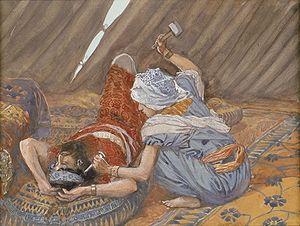
English: Jael Smote Sisera, and Slew Him, circa 1896-1902, by James Jacques Joseph Tissot (French, 1836-1902) or follower, gouache on board, 5 7/16 x 7 3/8 in. (13.9 x 18.8 cm), at the Jewish Museum, New York (Photo credit: Wikipedia)
The account of Jael and Sisera takes place within the story of Deborah, a judge of Israel who led a great victory over the army of Jabin, king of Canaan, lead by Sisera.
Sisera’s army is routed in spite of its superiority and Sisera flees on foot, with Barak, the Israelite general, in pursuit. Sisera flees to the tent of Jael, assuming to find sanctuary because of the peace between Jabin and Jael’s husband, Heber.
A nurturing, maternal motif forms in the story. Jael is first seen in her tent and comes out to invite Sisera in. Twice she calls him to “turn aside” and tells him to have no fear. The tent, as the woman’s domain, can be seen as a womb. In inviting Sisera to enter, there is a sense of protection as a baby in a womb.
That imagery continues as she covers Sisera with a rug as a mother might cover a baby. He asks her for a drink of water like a child might ask its mother. Jael, however, gives Sisera milk – more than he asked for and more comforting – and then covers him again, evoking further images of a mother and baby.
Sisera asks Jael to stand guard at the door of the tent and tell any men, “There is no man within.” From Sisera’s point of view, he has commanded her to protect him by lying, confident in his military authority. But Sisera has figuratively regressed from manhood to childhood in blindly trusting Jael; there really is no man within the tent.
Sisera sleeps like a baby, for although he has the leader of the opposition chasing him, he is able to trust Jael enough to sleep.
She takes up the hammer and tent peg – tools of a woman in that culture because they were the ones who moved the tents– and goes quietly to him like a mother tiptoeing to her child’s bedside to check his breathing while he sleeps.
However, the story violently twists and Jael drives the peg into Sisera’s head, killing him.
Jael is a hero to her people and yet the imagery makes us squeamish. We grapple with the motif twisted. How could a mother betray her baby? Why did Sisera relinquish his trust and his life to this woman?
Striking use of imagery makes Jael’s story a powerful one with many questions to be explored.
